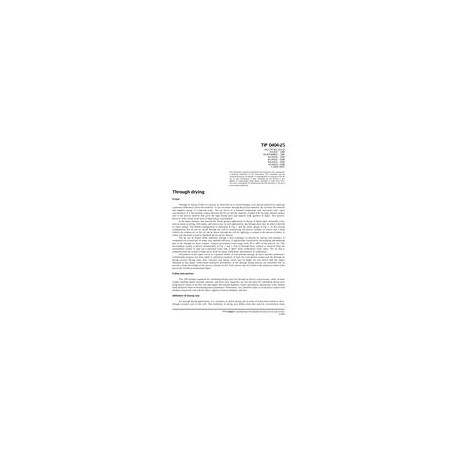Cart
0
Product
Products
(empty)
No products
To be determined
Shipping
$0.00
Total
Product successfully added to your shopping cart
Quantity
Total
There are 0 items in your cart.
There is 1 item in your cart.
Total products
Total shipping
To be determined
Total
New
 View larger
View larger
 View larger
View larger
TAPPI TIP 0404-25
M00011166
New product
TAPPI TIP 0404-25 Through Drying
standard by Technical Association of the Pulp and Paper Industry, 01/01/2009
In stock
More info
Full Description
ScopeThrough air drying (TAD) is a process in which hot air is forced through a wet, porous material by imposinga pressure differential across the material. As the air passes through the porous material, the air heats the materialand supplies energy to evaporate water. The air leaves at a reduced temperature and increased water vaporconcentration. It is the intimate contact between the hot air and the material, coupled with the large internal surfacearea of the porous material that gives the high drying rates and superior bulk qualities of paper. This process,however, often comes at the price of high energy consumption.
In the paper industry, this process has found greatest application in drying of lightweight, permeable webs,such as tissue, toweling, filter paper, and nonwovens. In such applications, the through dryer may be either a flat bedor rotary design. The flatbed configuration is illustrated in Fig. 1 and the rotary design in Fig. 2. In this secondconfiguration, hot air can be forced through the web by pressurizing the porous cylinder, in which case a hoodcollects the exhaust air, or hot air can be drawn through the web by applying a vacuum to the porous cylinder, inwhich case the hood is used to distribute the hot air (as shown).
The air can be heated either indirectly through a heat exchanger or directly by mixing with products ofcombustion of a clean fuel. In either case, thermal efficiency is significantly increased by recirculating and reheatingpart of the through air dryer exhaust. Typical recirculation rates range from 50 to 80% of the process air. Thisrecirculation system is shown schematically in Fig. 1 and 2. Part of through dryer exhaust is removed from therecirculation system to take out evaporated water and, if direct fired, combustion water vapor. The air that isexhausted from the system is made up by fresh air intake, infiltration, and products of combustion.
Information in this paper serves as a general outline of conventional through air dryer machine parameters.Considerable progress has been made in analytical treatment of both the recirculation system and the through airdrying process. Drying rates, flow velocities and energy levels may be higher for new dryers than the rangesindicated in this paper. Abbreviated analytical descriptions of the through drying process are presented here toprovide a basic knowledge of the process. Details on the TAD process may be found in the references listed at theend of this Technical Information Paper.

